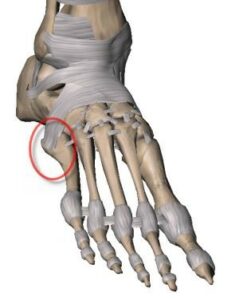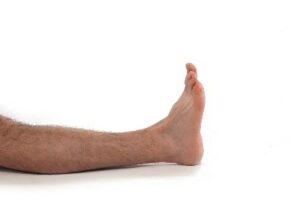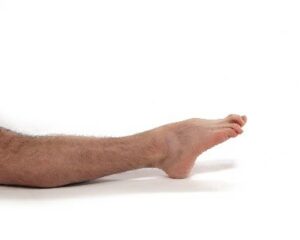- Reference Number: HEY1282/2025
- Departments: Orthopaedics
- Last Updated: 30 April 2025
Introduction
This leaflet has been produced to give you general information about your injury. We understand you may not have seen a clinician face to face in fracture clinic however, most of your questions should be answered by this leaflet. If after reading it, you have any concerns or require further explanation, please do not hesitate to contact the fracture clinic team. Contact details are available at the end of this leaflet.
What is a base of the 5th Metatarsal Fracture?
This is a break to the bone on the outside of the foot.

- The base of the fifth metatarsal bone can be fractured when the foot is forcefully turned inwards while putting weight through the leg. For example when twisting foot down a kerb or hole in the grass.
- The area circled in the image shows the base of the fifth metatarsal. The fracture you have sustained is undisplaced and should heal well.
How should it be treated?
This fracture can be treated simply in a tubigrip and you can place as much weight through the foot as you find comfortable with or without the help of crutches.
You may have been offered a removable slipper cast which can be removed when in bed, to exercise the ankle and for hygiene purposes. The cast can be walked on with or without the use of crutches. Once you can walk comfortably without the cast, it can be discarded. This should be no later than 5 weeks after its application.
To manage your pain, we advise that you regularly take simple pain relief, which can be bought over the counter. If you have allergies or conditions, which prevent the use of pain-relieving or anti-inflammatory medication, please seek advice from your doctor or a pharmacist.
It is really important to note that smoking will delay the healing process and so should be avoided. Talk to your GP or go to www.smokefree.nhs.uk for more information.
What should I do in the first few days?
Controlling the pain and swelling by following the principles of RICE are important:
R REST
Complete rest is not advisable. If necessary, you will be given crutches to help you take some weight off the injured foot. Exercises in the section below, can be started straight away.
I ICE
Ice will help reduce the pain in your foot and so should be applied for 10 to 15 minutes before performing any exercises. This will also help to reduce the swelling.
There are many different ways in which ice can be applied however crushed ice, in the form of frozen peas for example, is the most effective. Whichever method you choose it is important that you wrap the ice in a damp towel, in order to prevent it from ‘burning’ the skin.
Please Note:
- Only use an ice pack on areas that have normal skin sensation i.e. where you can feel hot and cold
- Do not apply ice to an open wound
- Do not apply an ice pack to an area that has poor circulation
- When you apply ice to your skin, check the skin every five minutes and stop using it if:
- the area becomes white, blue or blotchy
- the area becomes excessively painful, numb or tingles
C COMPRESSION
If you have been given a tubigrip to wear it is important this is removed if you develop any signs of poor circulation such as tingling, numbness, blueness of the skin of the foot and increasing pain. The tubigrip should be removed when you go to bed at night, as when you are asleep you cannot monitor these symptoms.
E ELEVATION
The leg should be elevated above the level of the heart as much as possible, as this will reduce and prevent swelling.

- Carrying out the movements of the ankle described below, while the leg is elevated, may help to reduce any swelling further
What exercises should I do?
The simple exercises described below will help prevent stiffness developing in the ankle and foot.
- Ankle dorsiflexion and plantarflexion


- Pull your toes up towards you slowly and then point them down as far as you can.
- Try to do this within your pain free range. Do not force the ankle or foot.
- This range will increase as your injury heals.
Ankle inversion and eversion


All photos with kind permission of ©Physiotec™
- Lie down on your back with the foot elevated so your heel does not touch anything, like on the picture opposite.
- Slowly turn your foot/ankle in, then out (like a windscreen wiper), without moving the upper leg.
How long will the pain and swelling persist?
Pain and swelling can persist for 3 to 6 months following the injury. We advise continuing to use simple analgesia such paracetamol to help control your pain and allow you to walk normally. Swelling is usually worse towards the end of the day. If this does occur, continue to use elevation as described previously.
Is there anything I should avoid during the recovery?
Once you are able to walk normally, you should gradually increase your level activity. You should avoid any impact activities and contact sports for 3 months in total. This includes running, jumping and dancing.
When can I start driving again?
You will not be insured to drive whilst using a plaster slipper. It is always good to check with your insurance company however we advise it should be safe to return to driving when:
- You are no longer using the plaster cast slipper
- You can walk comfortably
- You can perform an emergency stop
Do I require a follow up?
Do I need to be referred to Physiotherapy?
If the fracture clinic team feel you need to be seen by the Physiotherapy team, you will be directly referred to physiotherapy from fracture clinic and if this is the case, you will have been informed of this in your telephone call following your Virtual Fracture Clinic appointment. You will receive a letter or phone call to book this appointment within 2 weeks of the referral being made.
If you have not received one within this time, please contact the physiotherapy department on tel: 01482 674880 between the hours 8.00am to 4.00pm Monday to Friday. If there is no answer please leave a message and your call will be returned with the same working day.
Most of the time however, a referral to Physiotherapy is not needed, but if you have any concerns, are unable to follow the advice in this leaflet, or if you still have reduced movement, strength or function, East Riding GP patients can contact the East Riding MSK Physiotherapy service on tel: 01377 208300. Alternatively you can complete a self referral form on https://www.chcpmsk.org.uk/self-referral-form-introduction
Hull GP patients should call the fracture clinic number in the information below.
Do I need a Fracture Clinic follow up appointment?
A follow up appointment for fracture clinic is not required and you have been placed on a Patient Initiated Follow Up (PIFU) pathway. This means you will not have another appointment to be seen in fracture clinic.
If, however you have any problems or further queries relating to this injury within the next six weeks, you can contact us on tel: 01482 674378 during clinic hours 9.00am to 4.30pm Monday to Friday. Please do not choose an option and when prompted leave a message if there is no answer and we will aim to get back to you within the same working day. If you have not needed to contact us in the six weeks after your injury, you will be discharged and should seek advice from your GP.
This leaflet was produced by the Orthopaedic Department, Hull University Teaching Hospitals NHS Trust and will be reviewed in May 2025
General Advice and Consent
Most of your questions should have been answered by this leaflet, but remember that this is only a starting point for discussion with the healthcare team.
Consent to treatment
Before any doctor, nurse or therapist examines or treats you, they must seek your consent or permission. In order to make a decision, you need to have information from health professionals about the treatment or investigation which is being offered to you. You should always ask them more questions if you do not understand or if you want more information.
The information you receive should be about your condition, the alternatives available to you, and whether it carries risks as well as the benefits. What is important is that your consent is genuine or valid. That means:
- you must be able to give your consent
- you must be given enough information to enable you to make a decision
- you must be acting under your own free will and not under the strong influence of another person
Information about you
We collect and use your information to provide you with care and treatment. As part of your care, information about you will be shared between members of a healthcare team, some of whom you may not meet. Your information may also be used to help train staff, to check the quality of our care, to manage and plan the health service, and to help with research. Wherever possible we use anonymous data.
We may pass on relevant information to other health organisations that provide you with care. All information is treated as strictly confidential and is not given to anyone who does not need it. If you have any concerns please ask your doctor, or the person caring for you.
Under the General Data Protection Regulation and the Data Protection Act 2018 we are responsible for maintaining the confidentiality of any information we hold about you. For further information visit the following page: Confidential Information about You.
If you or your carer needs information about your health and wellbeing and about your care and treatment in a different format, such as large print, braille or audio, due to disability, impairment or sensory loss, please advise a member of staff and this can be arranged.

